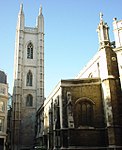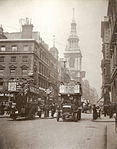Cordwainer (ward)

Cordwainer is a small, almost rectangular-shaped ward in the City of London. It is named after the cordwainers, the professional shoemakers who historically lived and worked in this particular area of London; there is a Livery Company for the trade — the Worshipful Company of Cordwainers. The ward is sometimes referred to as the "Cordwainers' ward". It is bounded to the north by Poultry and Cheapside (the boundary with Cheap ward); to the west by the eponymous Bread Street and the ward of the same name; to the south by Cannon Street (and Vintry and Dowgate wards); and to the east by Walbrook ward and a street of the same name. Streets within Cordwainer's boundaries are, amongst others, Bow Lane, Pancras Lane and part of Watling Street. Queen Street runs north–south through the centre of the ward.
Excerpt from the Wikipedia article Cordwainer (ward) (License: CC BY-SA 3.0, Authors, Images).Cordwainer (ward)
Watling Street, City of London
Geographical coordinates (GPS) Address Nearby Places Show on map
Geographical coordinates (GPS)
| Latitude | Longitude |
|---|---|
| N 51.51285 ° | E -0.09324 ° |
Address
St Mary Aldermary
Watling Street
EC4M 9BW City of London
England, United Kingdom
Open on Google Maps











